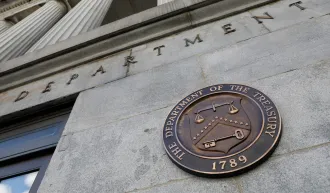A Fine Wine: Do Labels Make a Difference?
Research from Stanford’s Michael Hannan examines how consumers perceive the value of organic and biodynamic Alsatian wines.
February 04, 2013

At the Teliani Valley wine factory east of Tbilisi, Georgia (Reuters photo by David Mdzinarishvili)
As any teenager knows, the key to achieving higher social status is wearing the right labels. Now, a team of researchers has determined that the same principle holds true for wine. In a study of 3,545 wines from 96 wineries in the Alsace region of France, Michael Hannan, the Stratacom Professor of Management in Stanford GSB, and organizational behavior PhD student Magali Fassiotto, along with Emory University’s Giacomo Negro, associate professor of organization and management, discovered that vintages produced under guidelines associated with strict labels were more likely to receive higher ratings from consumers and critics than those that weren’t.
The researchers focused on two popular approaches to winemaking in Alsace: organic, and the more unconventional biodynamic. They speculated that adherence to their methods signaled to consumers higher commitment to quality winemaking; after all, following a set of proscribed rules requires greater attention and skill, not to mention higher production costs. The bigger the contrast to traditional methods, the more strongly the product would be valued.
To gather their data, Hannan and his colleagues interviewed Alsatian winemakers in the field, conducted surveys, and examined archival sources. They also looked at the ratings supplied by three esteemed critical guides: Le Guide de Vins de France, by Gaut et Millau (GM); Wine Spectator magazine; and Robert Parker’s Wine Buyer’s Guide. They were particularly interested in biodynamic winemaking, an uncommon approach “based on principles involving cosmic forces that outsiders find bizarre,” as they explained in their study, Category Signaling and Reputation.
First proposed by Austrian polymath Rudolph Steiner in the 1920s, biodynamic farming treats the farm as a living organism tied to the cycles of the whole cosmos. Compared to the high-tech scientific production methods favored by New World winemakers, biodynamic farming sounds a lot like voodoo. It requires certain organic preparations applied at highly specified times. For instance, vintners are instructed to bury cow horns filled with the manure of lactating cows fed on biodynamic grain in the soil on the autumn equinox, and dig them up on the first day of spring. Then, the winemakers must combine one teaspoon of the cured manure with water, stir for an hour, and then spray the mixture on their vines, timed to the descending phases of the moon. Other biodynamic dictates include burying yarrow flowers “sheathed in a stag’s bladder” and spraying valerian flower juice on compost. “Proponents of biodynamics argue that the organic code tells what not to do while the biodynamic code fills in what should be done and provides detailed guidance on how to do it,” the researchers wrote.
Alsatian vintners began turning to biodynamic and organic production in large part because they believed damage to the landscape was lowering the quality of their wines. According to one winemaker the researchers interviewed, chemical pesticides were considered a miracle — at first. “It took years to realize that, ‘Oh, it was supposed to help me but, in fact, I’m getting more and more disease and more problems, and my soil has lost its fertility,’” he told them. Biodynamic and organic techniques were widely viewed as the antidote to declining quality. “I was thinking … we should turn to a better agriculture,” another vintner told them. “We were destroying what is the foundation of everything.” In 1980, the region boasted just one biodynamic winery and one organic one; by 2010, there were 30 biodynamic and 44 organic wineries.
Hannan’s team found that both biodynamic and organic farming improved the soil quality over traditional methods of cultivation. But the eccentricity of biodynamic farming gave it a clearer distinction. “If viticultural science tells us that these methods produce similar improvements, we reasoned that the romantic, nonrational imagery of biodynamics and its apparatus of precepts could serve as the basis for a very distinctive identity in the market even though the identity could be valued either positively or negatively,” they wrote.
Organic farming, by comparison, was more common and familiar to consumers, but also had murkier guidelines; it overlapped with “sustainable,” which some makers described as “nearly organic” or using “minimal” chemicals. Furthermore, the researchers concluded that winemakers who decided to turn biodynamic possessed superior quality to begin with, whereas those who opted to go organic did not, necessarily. Certification in either category provided a boost in reputation and sales; in Robert Parker’s 2008 ratings of Alsace wines, for instance, six of the top ten producers (those rated “exceptional”) were biodynamic and two were organic. Of those ranked “excellent,” five were biodynamic and three organic. Both cost more to produce and commanded higher retail prices, though not high enough to substantially increase profits.
Regardless, some winemakers shied from marking their bottles with the designation of biodynamic or organic, fearing it would breed complacency or create an unearned aura of superiority. “Don’t just come to me because I am into biodynamic farming,” one said. “Come to me because I have good products and, on top of that, I’ll give you a present: they’re biodynamic.” Others worried that the certification would rob them of their individuality as winemakers. “My ego is bigger than the label,” one vintner told them.
But labels ultimately played a minor role in signaling quality, at least of biodynamic wines: Somehow, the wine itself reflected the care and precision that the designation had demanded. In their final analysis, looking at dry Alsatian white wines from 1981 through 2008, the researchers concluded that wines made by biodynamic vintners received higher critical ratings than those not certified as such — whether they were tasted blind or with the labels showing. Formal certification increased the ratings when the taster could see the producer.
With organic wines, critics rated them as high as — or higher than — biodynamic ones, but only when they tasted them blind. When they knew the producers, their ratings dropped. And visible formal certification made them fall even further. Ultimately, Hannan, Fassiotto, and Negro determined that “category signaling” had an effect on the perceived quality of the wine produced, especially when the category was defined by more distinctive characteristics. After all, nothing says good wine like a cow horn filled with manure.
For media inquiries, visit the Newsroom.
Explore More

What Makes Some Words More Memorable Than Others?

To Make Influencers Seem More Authentic, Just Add #Friends



